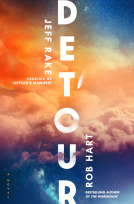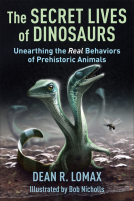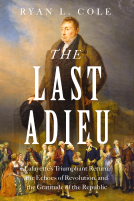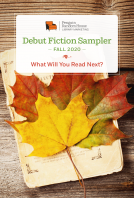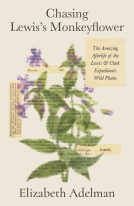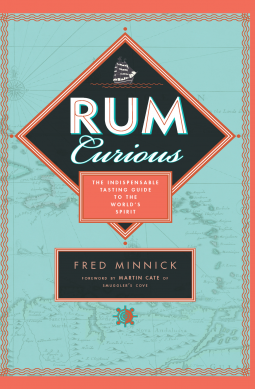
Rum Curious
The Indispensable Tasting Guide to the World's Spirit
by Fred Minnick
This title was previously available on NetGalley and is now archived.
Send NetGalley books directly to your Kindle or Kindle app
1
To read on a Kindle or Kindle app, please add kindle@netgalley.com as an approved email address to receive files in your Amazon account. Click here for step-by-step instructions.
2
Also find your Kindle email address within your Amazon account, and enter it here.
Pub Date Jun 01 2017 | Archive Date Sep 08 2017
Quarto Publishing Group – Voyageur Press | Voyageur Press
Description
Rum Curious takes the you on a tour of the world of rum by teaching you how to taste and appreciate all of its glorious variety.
Once the drink of sailors and swashbuckling pirates, rum is the most versatile--and the most varied--spirit in the world. It is consumed neat as a sipping drink, on the rocks, and in a dizzying variety of cocktails, like the mai tai, mojito, and pina colada.
In Rum Curious, author Fred Minnick first takes you on a whirlwind tour of the world of rum, describing its many styles; explaining the great variety of fermenting, distilling and maturing processes; and highlighting distillers and distilleries. Minnick explains the finer point of how to properly taste rum -- how to reveal the experience offered by brands ranging from the familiar to the unusual and obscure.
The book's final section is a highly curated collection of recipes for classic and innovative rum cocktails from around the world. Rum Curious is the one book the reader will need to understand and appreciate rum in all its glorious variety.
Available Editions
| EDITION | Other Format |
| ISBN | 9780760351734 |
| PRICE | $25.00 (USD) |
| PAGES | 240 |
Average rating from 9 members
Featured Reviews
 Reviewer 312499
Reviewer 312499
I don’t necessarily have a love affair with rum or rum cocktails, especially after an ill-fated evening of mojitos at a dinner party at my house almost a decade ago. However, I am always generally curious to learn more about the spirits that I stock in my cabinet, so I thought that Rum Curious would be an interesting read. Without looking into my liquor cabinet, I’m pretty sure that I have a bottle of Don Q silver rum, Sailor Jerry spiced rum, and Goslings Black Seal rum hiding in there. Aside from making a mean Dark and Stormy while in Bermuda, I definitely have to rely on recipes when it comes to mixing rum cocktails.
As stated in his Introduction, the author’s intent is to help consumers make wise rum purchasing decisions by delivering a rum guide “with a touch of history, production information, cogent tasting notes, scores, and classic and contemporary cocktails.” He hopes to educate consumers as well as provide recipes for cocktails that will be fun to make at home.
After the introductory material, the book is basically divided into two parts – About Rum and Tasting Rum – that are followed by two appendices – Distillery Production Notes and Rum Resources.
About Rum begins with a short history of rum, including the history of the sugarcane, the most notable early discovery of which was recorded by one of Alexander the Great’s admirals in 325 BCE. The earliest known spirit distillation using sugarcane was in Brazil in the 1500s; however, the spirit distilled from molasses did not begin until the 1650s. The somewhat academic feeling text traces the influence of rum on United States history, as well as the influence of the popularity of American whiskey and the sugar beet on rum trade. The section continues with a discussion of the production of rum, which begins again with the sugarcane and ends with a discussion of the controversy over adding sweeteners to the rum at some point after distillation. A discussion of Rules and Regulations concludes the section by providing an overview of rum regulations that exist at all levels of government from the United Nations to each individual Caribbean island and by listing regulated terms for style. The master distiller of Foursquare, the master blender of Appleton Estates, and the founders of Richland Rum are heavily cited and quoted throughout the About Rum section, leaving an impression of bias in the author’s writing. Throughout this part of the book are pink call-out boxes with additional information or recipes to supplement the text.
Tasting Rum is composed of five sections: unaged rums, aged rums, flavored rums, other cane spirits, and cocktails. The author asserts that tasting rum is different than tasting whiskey or brandy; the color matters little to the quality of the rum, and what is important is smell, taste, and finish. According to the author, “[w]hen sampling rum, the nose does not lie … rum’s taste tends to follow the aroma it initially presents.” After a brief overview on tasting rum, the author scores a wide variety of rums in his four categories on a scale of 100 (where 59 and below is not recommended) and then offers some cocktail recipes. There are approximately 40 pages of rum ratings, and 15 pages of cocktail recipes. In each rum chapter, the rum is clearly identified, along with its percentage alcohol by volume and point of origin. The rums are presented in alphabetical order. The author describes the aroma and the palate of the rum, assigns it a score, and advises on how to drink the rum. There is absolutely no information about the objective criteria that the author used to come up with his score, so the scores seem rather whimsical. Oddly, the author is a fan of recommending rums be mixed into Old Fashioned and replace whiskey in other drinks. With respect to the unaged rums that are typically mixed in cocktails, the author is looking for flavor, but is also basing his scores in this category on their mixability and sipping merits. For aged rums, the author is looking for flavor that is not derived from additives and bases his scores more on sipping merit. Cigar pairing recommendations are offered for aged rums that score over 90 on his scale. With respect to flavored rums, the author is looking for a nonchemical taste and sipping quality. The cocktail recipes list the ingredients and the method, and sometimes the tools, the glassware, the topping, and the garnish. They range from the Classic Daiquiri in the Easy to Make Cocktails section to the Vinho Carousel in the Pro Level Rum Cocktails section. The Easy to Make Cocktails definitely seem familiar and possible with my liquor cabinet, but the Pro Level Rum Cocktails do not. The latter seem to each require either some type of foam or whipped cream or special sugar syrup that is made in such volume that is impractical for preparing one cocktail at a time.
The Distillery Production Notes are notes gathered from the distilleries themselves, sources within the organizations, and previously published material that might suggest a particular brand’s flavor profile. For each distillery, the notes might include the location, water source, source material, distillation, off-the-still proof, barrel-entry proof, maturation, filtration, color added, sugar added, flavoring, and cold stabiliztion. The notes for Appleton Estates includes almost all of these factors, while the notes for Bacardi and Don Q includes only location and off-the-still proof. The distilleries profiled range from the esoteric Phraya in Thailand and Montanya in Colorado to household names like Mount Gay and Goslings. The Rum Resources is approximately one page of web resources and another half page of print resources to learn more about rum. There are no resources for ordering rum online or finding rum in stores …
The artwork in the book is a combination of author photography of locations, rums, and cocktails; stock photography; and historical images. The artwork adds a richness to the book.
I don’t think I will add this book to my already extensive culinary library because the bulk of the book was composed of the rum ratings. I am not so into rum that I would refuse Goslings Black Seal in my Dark and Stormy or Sailor Jerry in my Hurricane. I am still working on the differences between Islay Scotches, so the differences between different aged rums seems too subtle to me. However, I would recommend this book for anyone who is serious about their rums because the rum ratings do span a wide variety of brands from a wide variety of countries.
 Bill C, Reviewer
Bill C, Reviewer
Rum Curious by Fred Minnick is a lightly informative look at the history of rum production and consumption, followed by a sizable list ranking different types of rum and a decent sized list of cocktail recipes. It’s not an academic study, it doesn’t go into a lot of depth or detail, but that’s obviously not its purpose, so as long as one goes in with the right expectations, it’s an enjoyable, informative read.
The history includes pirates (because, you know, rum), the way rum was woven into slavery and imperialism, among other elements. As noted, it’s mostly a quick skim through, which Minnick himself recognizes, noting at one point for instance that he hasn’t the space to go into the Bacardi/Cuba history.
Minnick’s goal here, beyond giving some historical context, is to help break out of the rut that “novice consumers think that rum’s flavor profile is that of Captain Morgan, that premium ‘white’ rum is Bacardi, and that a sipping rum is Cruzan Single barrel — because these are the products they see, buy, and taste (he does a nice job as well of explaining why that is, a result of govt. subsidization). The book is detailed in its production notes, and Minnick spends a good amount of time on the sugar additive issue, usefully including a list of makers who do or don’t add, as well as explaining how consumers can find a more exhaustive list. One’s response will probably depend on how much detail one wants, but it’s easy to skim through if uninterested in a particular area. I, for instance, found the whole barrel explanation fascinating.
He then offers up an extensive ranking of various rums, with a clear explanation of what he does and does not look for in a good rum and then detailed notes on what flavors are expressed in each rum, if they’re better to sip or mix, and if the latter, what particular cocktails the rum would go well in. Minnick is fully honest and transparent about the subjective nature of this and has a nicely light tone (I laughed aloud at several of his admonitions about not mixing the great rums, such as warning that the rum gods might come after you).
If you’re looking for a deep history of rum or its place in geopolitical history, this isn’t the work for you. But if you’re looking for a little bit of history, a nicely lucid explanation of how rum is made and what affects its flavors, and a truly generous listing/ranking of rums, Rum Curious is an excellent resource with a nice conversational style that doesn’t take itself overly serious. I’m looking forward to trying some of the sipping rums, and several of the cocktails.
 dale d, Reviewer
dale d, Reviewer
I would recommend this book. It details a fun travelogue/history of Rum and is a fun read for fans of the drink or adventure
 Ken B, Reviewer
Ken B, Reviewer
In Rum Curious, Fred Minnick gives a shot history of rum and its distillation methods and a tumbler full of reviews of current rum releases.
I found the thorough rum reviews at the back of the book to be interesting and well worth the purchase for anyone hoping to explore the shelves of their local liquor store. Thought I imagine most of the releases would be hard to find at your corner store.
Rum Curious also includes a useful section on mixing cocktails. I do wish this part of the book had been expanded with more detail given into how to properly drink and sample different rums.
The author does have a chip on his shoulder about rum’s place in the spirits world. He complains a little too much about the lack of respect rum gets from consumers. While the book would have benefited from less complaining and more positive proselytizing, I did learn a lot about the current state of rum production across the world, and particularly in the Caribbean where it is centered.
Readers who liked this book also liked:
Dean R. Lomax; Robert Nicholls
Nonfiction (Adult), Outdoors & Nature, Science
Kalan Chapman Lloyd
General Fiction (Adult), Literary Fiction, Women's Fiction
